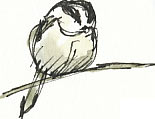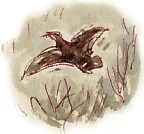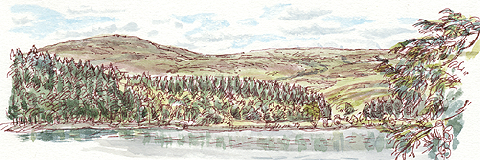
Until this summer the tall dark conifers of North America
Plantation obscured this view of the reservoir from the moor.
Wild West Yorkshire, Friday, 31 December 2010
previous | this month | next

Until this summer the tall dark conifers of North America
Plantation
obscured this view of the reservoir from the moor.

 OUR MORNING at Langsett Reservoir got off to a good start when, as we got out of the car, a flock of long-tailed and blue tits flew into the conifer above us.
OUR MORNING at Langsett Reservoir got off to a good start when, as we got out of the car, a flock of long-tailed and blue tits flew into the conifer above us.
The reservoir was almost entirely frozen over but 29 teal and 25 mallard had gathered at a small  ice-free patch near the river inlet. While the mallards were making their familiar quacking, the calls of the teal carried further; a sort of squeaky whistling call, I could imagine it as the noises you'd hear from three squeaky roundabouts in a children's playground.
ice-free patch near the river inlet. While the mallards were making their familiar quacking, the calls of the teal carried further; a sort of squeaky whistling call, I could imagine it as the noises you'd hear from three squeaky roundabouts in a children's playground.
Lars Jonsson in Birds of Europe, describes the male teal making “a short, bell-like ringing 'krick' or 'kreek' like a house-cricket”. That describes the calls we heard.


 I asked a passing hiker to take a photograph of Barbara and I and, as he was taking it, I spotted a red grouse strutting around in the heather ten yards behind him. We saw and heard perhaps a dozen in total as we crossed the moor. They've survived the recent snows when their natural food of heather shoots must have been largely buried, but the rabbits appear not to
I asked a passing hiker to take a photograph of Barbara and I and, as he was taking it, I spotted a red grouse strutting around in the heather ten yards behind him. We saw and heard perhaps a dozen in total as we crossed the moor. They've survived the recent snows when their natural food of heather shoots must have been largely buried, but the rabbits appear not to ![]() have fared so well with a couple of casualties lying by the path – one of them with no signs of having been attacked by a predator or scavenger.
have fared so well with a couple of casualties lying by the path – one of them with no signs of having been attacked by a predator or scavenger.
 Moles don't seem to suffer because of snow cover; their mole-hills are much in evidence in grassy areas around Langsett, although I didn't see any mole-hills on the moor; I guess that because of the acid conditions there are no earthworms in the peat and the rocky subsoil.
Moles don't seem to suffer because of snow cover; their mole-hills are much in evidence in grassy areas around Langsett, although I didn't see any mole-hills on the moor; I guess that because of the acid conditions there are no earthworms in the peat and the rocky subsoil.
 A new sign explains that the recent clearance of conifers on the slopes at the far side of the lake marked the start of a scheme by Yorkshire Water, working with the RSPB, the FSC and the Forestry Commission, to reverse woodland bird decline by managing the 25 hectare North America plantation by encouraging the regeneration of native trees such as oak, birch, hazel, blackthorn, willow and rowan. The East Midlands Woodland Bird Project also aims to identify micro habitats, such as wet areas and flushes.
A new sign explains that the recent clearance of conifers on the slopes at the far side of the lake marked the start of a scheme by Yorkshire Water, working with the RSPB, the FSC and the Forestry Commission, to reverse woodland bird decline by managing the 25 hectare North America plantation by encouraging the regeneration of native trees such as oak, birch, hazel, blackthorn, willow and rowan. The East Midlands Woodland Bird Project also aims to identify micro habitats, such as wet areas and flushes.
The conifers were planted in 1962, so the dark lakeside plantations have always been a feature of Langsett for me. I look forward to seeing more varied patchwork of woodland, wetland and heathy habitats develop, hopefully encouraging nightjar, tree pipit, willow warbler, lesser redpoll, pied flycatcher, wood warbler and lesser spotted woodpecker to return.

Where the Porter, also known as the Little Don, broadens as it enters the top end of the reservoir there's a long patch of foam on the ice-fringed river. In the prolonged cold spell, the foam must have frozen to produce a kind of natural sorbet.
For the latest Wild West Yorkshire pages please see my new: blog.wildyorkshire.co.uk
Richard Bell, illustrator
previous | this month | Wild West Yorkshire home page | next